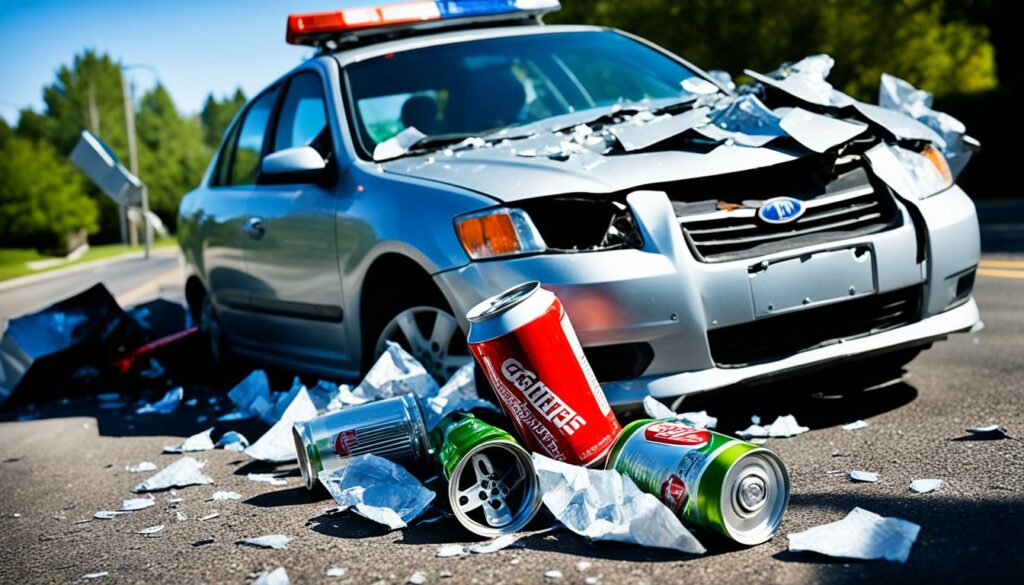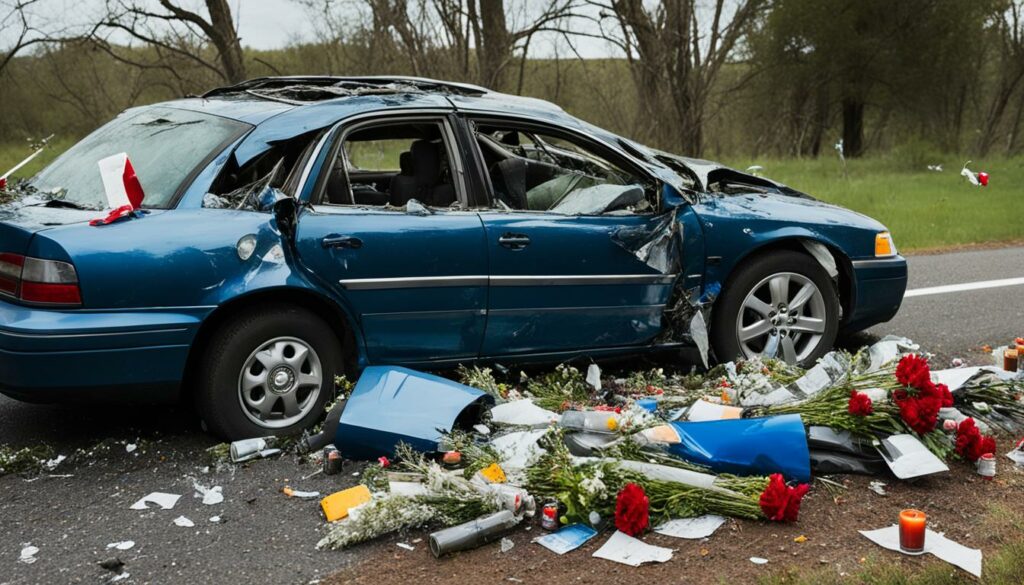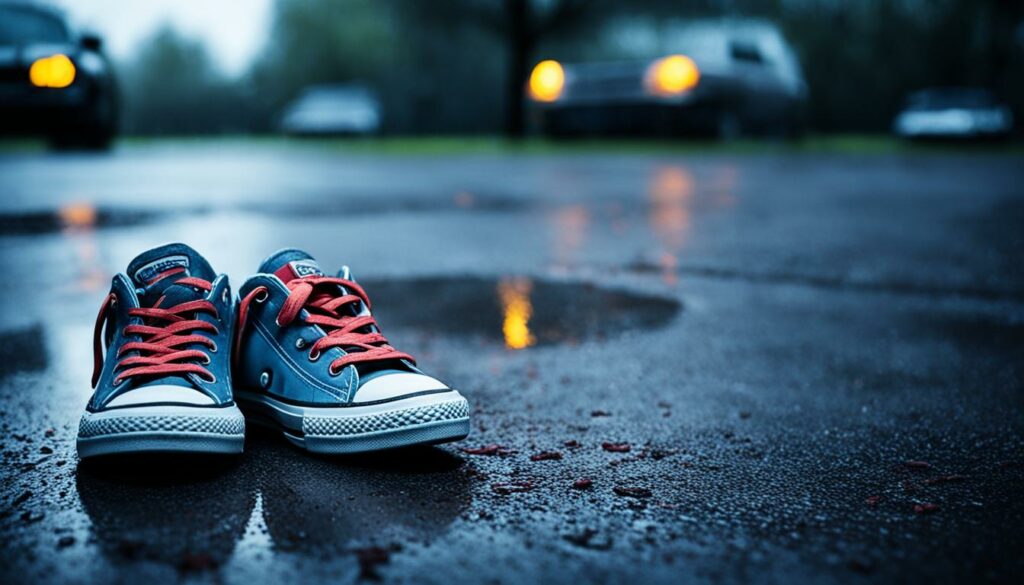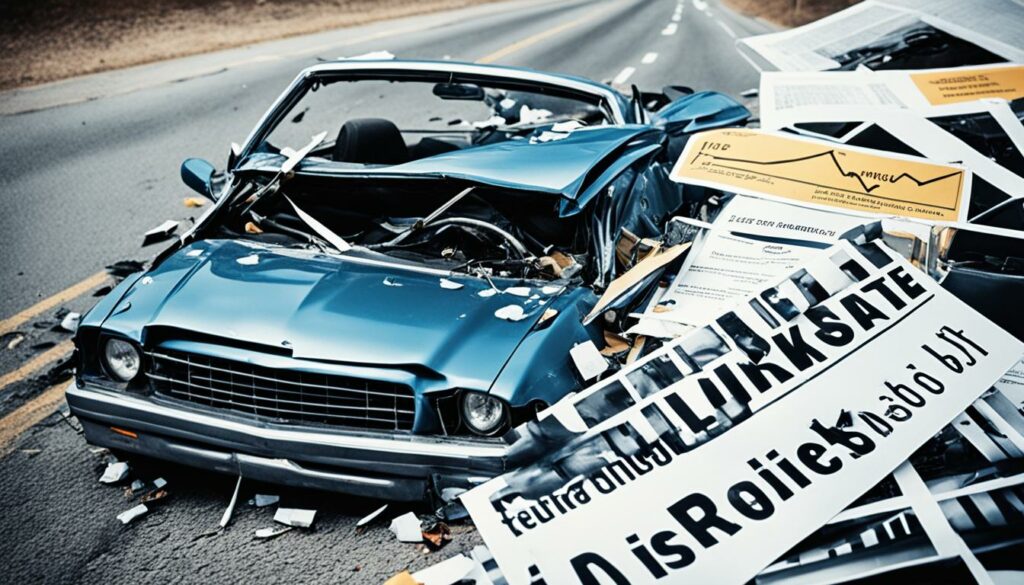Teen Drunk Driving Fatalities Statistics
According to recent statistics, alcohol-impaired driving is a significant problem among teenagers in the United States. In 2021, there were 2,266 people killed in alcohol-related crashes where the driver had a blood alcohol concentration (BAC) of .01 to .07 g/dL. Car crashes are the leading cause of death for teens, with about a quarter of fatal crashes involving an underage drinking driver. It is essential to understand the impact of alcohol on teenage driving and the need for prevention efforts to save young lives.
Key Takeaways:
- Teen drunk driving is a significant problem in the United States.
- In 2021, there were 2,266 people killed in alcohol-related crashes involving teens.
- About a quarter of fatal crashes among teens involve an underage drinking driver.
- Car crashes are the leading cause of death for teenagers.
- Prevention efforts are crucial to saving young lives and reducing drunk driving fatalities among teens.
The Effects of Alcohol on Teenage Driving

Alcohol has a significant impact on the driving abilities of teenagers. It impairs various brain functions that are essential for safe driving, including thinking, reasoning, and muscle coordination. Even a small amount of alcohol can affect a teenager’s ability to operate a vehicle safely.
Blood alcohol concentration (BAC) is a measure of the amount of alcohol in the blood. At a BAC of .08 g/dL, the risk of a crash increases exponentially. It is important to note that it is illegal in all 50 states, the District of Columbia, and Puerto Rico to drive with a BAC of .08 or higher.
“Alcohol impairs various functions of the brain, including thinking, reasoning, and muscle coordination, all of which are crucial for safe driving.”
However, even lower BAC levels can still impair driving skills. This means that even if a teenager’s BAC is below the legal limit, they may still experience negative effects on their ability to drive safely.
It is crucial to educate teenagers about the impact of alcohol on their driving abilities. By raising awareness of these effects, we can empower young drivers to make responsible decisions and avoid getting behind the wheel while under the influence.
| Effects of Alcohol on Teenage Driving: | Impact on Driving Abilities |
|---|---|
| Impairs thinking and reasoning skills | Increases reaction time |
| Affects muscle coordination | Reduces concentration and attention |
| Impairs judgment and decision-making | Decreases vision and peripheral awareness |
“Even a small amount of alcohol can affect a teenager’s ability to operate a vehicle safely.”
By highlighting the negative effects of alcohol on teenage driving, we can strive to prevent accidents, injuries, and fatalities on the roads. It is crucial to promote responsible behavior and emphasize the importance of sober driving for the safety of young drivers and everyone sharing the road with them.
Drunk Driving Fatalities Among Teenagers

Drunk driving has devastating consequences for teenagers, leading to a significant number of fatalities each year. According to statistics from 2021, there were 13,384 people killed in alcohol-related crashes in the United States. What’s even more concerning is that approximately 27% of young drivers involved in fatal crashes were between the ages of 15 and 20. This indicates a disturbing trend of teenage drunk driving deaths.
Teenagers accounted for one-fifth of all alcohol-related crashes, despite representing only about 6% of the overall licensed population. These statistics highlight the disproportionate impact of drunk driving on the teenage population. The risks faced by teenage drivers are further compounded by their relative lack of experience behind the wheel, making them more vulnerable to the dangers of driving under the influence.
It is crucial for society to address this issue and implement effective preventive measures to reduce the number of drunk driving fatalities among teenagers. Through educational initiatives, stricter enforcement of laws, and increased awareness, we can work towards creating a safer environment for young drivers.
By understanding the severity of the problem and taking proactive steps to prevent teenage drunk driving deaths, we can ensure the safety and well-being of our young drivers.
Teenage Drunk Driving Statistics by State

The prevalence of teenage drunk driving varies by state, but it remains a significant issue nationwide. In an effort to reduce alcohol-related fatal crashes among youth, all states in the United States have adopted a minimum legal drinking age of 21. This proactive measure has had a positive impact on saving lives. From 1975 to 2017, minimum-drinking-age laws are estimated to have saved a staggering 31,959 lives.
While the effectiveness of these laws is evident, it is crucial to examine the current statistics regarding teenage drunk driving by state. The highest percentage of drunk drivers, with blood alcohol concentrations (BACs) of .08 g/dL or higher, in 2021 were found in the 21-24 and 25-34 age groups. This data emphasizes the need for continued education, enforcement, and prevention efforts across the nation to combat underage drinking and its devastating consequences on our roadways.
Teenage Drunk Driving Statistics by State
| State | Number of Alcohol-Related Fatal Crashes Involving Teen Drivers | Percentage of Teen Drivers in Alcohol-Related Fatal Crashes |
|---|---|---|
| Alabama | 62 | 22% |
| Alaska | 13 | 17% |
| Arizona | 59 | 19% |
| Arkansas | 41 | 21% |
| California | 298 | 16% |
These statistics highlight the variation in teenage drunk driving rates across different states. While some states have made significant progress in reducing these incidents, there is still work to be done to ensure the safety of our young drivers and others on the road. Increased awareness, education, and enforcement efforts are vital to continue making positive strides in preventing teenage drunk driving and the tragedies it causes.
Teenage Drunk Driving Awareness and Prevention

Preventing teenage drunk driving requires increased awareness and effective prevention strategies. It is crucial to educate teenagers about the dangers of impaired driving and empower them to make responsible choices. One way to raise awareness is through impactful campaigns such as “Drive Sober or Get Pulled Over” and “Buzzed Driving Is Drunk Driving,” which highlight the grave consequences of driving under the influence of alcohol. These campaigns aim to instill a sense of responsibility and encourage teenagers to think twice before getting behind the wheel while impaired.
The Role of Parents in Prevention
Parents play a vital role in teenage drunk driving prevention by fostering open lines of communication with their children. It is essential for parents to have ongoing discussions about the dangers of driving under the influence and to set clear expectations regarding alcohol consumption. By openly discussing the topic, parents can address any misconceptions and reinforce the importance of making safe choices. Additionally, parents can encourage their teenagers to have a designated driver or utilize alternative rideshare services when planning to consume alcohol. These proactive steps can significantly reduce the risk of teenage drunk driving incidents.
“Parents can make a significant impact on their teenagers’ attitudes and behaviors towards drunk driving by actively engaging in conversations and guiding them towards responsible decision-making.”
Collaboration with Schools and Communities
Prevention efforts should extend beyond parental involvement and encompass partnerships with schools and communities. Schools can implement educational programs that address the dangers of drunk driving and provide teenagers with the necessary knowledge and skills to make responsible choices. Communities can organize awareness events, such as seminars and campaigns, to educate teenagers and their families about the risks associated with drunk driving. By creating a supportive network of educators, peers, and community members, we can collectively work towards reducing teenage drunk driving incidents.
Empowering Teenagers with Alternative Options
Teenagers should be encouraged to explore alternative options that prioritize their safety when socializing. They can join or create peer groups that promote safe activities and events, such as alcohol-free parties or gatherings. This not only provides teenagers with an opportunity to have fun but also reinforces the message that responsible choices can coexist with an active social life. Furthermore, teenagers can utilize rideshare services or public transportation as alternatives to driving under the influence. By empowering teenagers to seek safer alternatives, we can minimize the occurrence of teenage drunk driving incidents.
Preventing teenage drunk driving requires a multi-faceted approach that involves education, parental involvement, collaborations with schools and communities, and empowering teenagers to choose safe alternatives. By raising awareness about the risks and consequences associated with drunk driving, we can create a safer environment for teenagers and ultimately save young lives.
Motorcycle Fatality Rates Among Drunk Teenagers

While drunk driving among teenagers is often associated with car accidents, it is important to recognize that motorcycle operators are also at a high risk. In fact, motorcycle riders involved in fatal crashes have a significant percentage of alcohol-impaired drivers compared to other vehicle types. According to data from 2021, 29% of motorcycle riders killed in accidents had a blood alcohol concentration (BAC) of .08 g/dL or higher.
This alarming statistic highlights the need for comprehensive education and prevention efforts to address the issue of drunk driving not only in cars but also on motorcycles. It is crucial for both teenagers and adults to understand the dangers of consuming alcohol before getting on a motorcycle.
| Year | Total Motorcycle Riders Killed | Motorcycle Riders with BAC of .08 g/dL or higher | Percentage |
|---|---|---|---|
| 2021 | 5,605 | 1,624 | 29% |
“Education and awareness play a crucial role in preventing drunk driving among teenage motorcycle operators. By promoting responsible alcohol consumption and providing information on the risks associated with impaired driving, we can work towards reducing the number of fatalities on the road.”
Prevention efforts should aim to address the specific challenges faced by motorcycle operators, such as the need for proper protective gear, increased visibility, and advanced riding skills. By implementing comprehensive strategies that target both teenage drivers and motorcycle enthusiasts, we can strive to create a safer environment for everyone on the road.
Repeat Offenders and Drunk Driving
Repeat offenders who drink and drive pose a significant risk on the roads. Drivers with a BAC of .08 g/dL or higher involved in fatal crashes were four times more likely to have prior convictions for driving while impaired than drivers with no alcohol. This emphasizes the urgent need for stricter enforcement and continued efforts to address repeat offenders and prevent future tragedies.
Impact on Children and Financial Cost of Drunk Driving

Drunk driving not only endangers the lives of those behind the wheel but also puts other innocent individuals at risk, including children. Shockingly, in 2021, 25% of children aged 14 and younger who lost their lives in motor vehicle crashes were involved in drunk-driving incidents. This heartbreaking statistic underscores the devastating consequences of drunk driving on our most vulnerable population.
Furthermore, the financial toll of drunk driving is staggering. Impaired-driving crashes cost the United States a staggering $68.9 billion annually. These costs include medical expenses, property damage, legal fees, and lost productivity. The enormous financial burden placed on our society due to drunk driving underscores the urgency of implementing effective preventive measures.
These sobering numbers prove that the consequences of drunk driving reach far beyond the immediate incident. Lives are forever shattered, families left to grieve, and communities burdened with the aftermath. It is imperative that we collectively work towards reducing the occurrence of drunk driving and creating safer roads for everyone.
Teen Driving Risks and Statistics

Teenagers face significant risks on the road, with car crashes being the leading cause of death for this age group. They are four times more likely to die or be injured in a car crash than older individuals. The first year of driving is particularly dangerous for teens due to their lack of experience behind the wheel. Factors such as speeding, running red lights, and driving under the influence contribute to the high crash risk among teenagers.
The Dangers of Teen Driving
- Car crashes are the leading cause of death for teenagers
- Teenagers are four times more likely to die or be injured in a car crash than older individuals
- Lack of experience behind the wheel increases the risk for teenage drivers
- Speeding, running red lights, and driving under the influence contribute to the high crash risk among teenagers
“The first year of driving is critical for teens. It’s crucial for them to develop safe driving habits and understand the risks involved to reduce the likelihood of accidents,” says Dr. Sarah Johnson, a traffic safety expert.
| Statistic | Percentage |
|---|---|
| Leading cause of death for teenagers | Car crashes |
| Likelihood of teenage drivers to die or be injured in a car crash compared to older individuals | 4 times |
| Contributing factors to high crash risk among teenagers | Speeding, running red lights, driving under the influence |
Underestimation of Dangerous Situations and Risky Behaviors Among Teens
When it comes to driving, teenagers often underestimate or fail to recognize dangerous situations, which significantly increases their risk of being involved in car crashes. Moreover, they tend to engage in various risky behaviors that further amplify this risk. These behaviors include:
- Speeding: Teens are more likely to exceed the speed limit, disregarding the potential consequences of their actions.
- Running red lights: Ignoring traffic signals puts both the teenager and other drivers at risk of collisions.
- Making illegal turns: Reckless turns without abiding by traffic laws can lead to accidents.
- Riding with an intoxicated driver: Teens may willingly get into a car with a driver who has consumed alcohol, jeopardizing their safety.
- Driving after using alcohol or drugs: Engaging in substance abuse impairs judgment and motor skills, making it extremely dangerous to operate a vehicle.
These risky behaviors significantly increase the likelihood of teen drivers getting involved in car crashes and suffering from severe injuries. To combat this issue, education and awareness campaigns are essential in addressing these risky behaviors and promoting responsible driving habits among teenagers.
The Importance of Targeted Education and Awareness Campaigns
It is crucial to educate teens about the dangers associated with risky driving behaviors and provide them with tools and resources to make informed decisions behind the wheel.
By targeting specific risky behaviors and highlighting their potential consequences, education and awareness campaigns can help alter teenage perceptions and encourage safer driving habits. These campaigns should emphasize the risks of speeding, running red lights, making illegal turns, riding with intoxicated drivers, and driving under the influence of alcohol or drugs.
The goal is to empower teenagers with the knowledge and understanding necessary to make responsible choices. By addressing risky behaviors head-on, we can reduce the number of car crashes involving teens and promote a culture of safe and responsible driving.
Parental Involvement and Communication in Teen Driving Safety
When it comes to teen driving safety, parents play a critical role in shaping their children’s behavior on the road. Research shows that teens with involved parents are less likely to engage in risky driving practices, such as crashing or driving while intoxicated.
One of the key ways parents can promote safe driving is by keeping the lines of communication open. Honest and frequent conversations about the importance of safe driving and the dangers of impaired driving can have a significant impact on a teenager’s decision-making behind the wheel.
Setting clear rules and expectations regarding safe driving is also essential. Parents should establish guidelines regarding speed limits, seat belt usage, and avoiding distractions while driving. These rules provide structure and reinforce the importance of responsible behavior on the road.
“Communication is key, and it’s crucial for parents to create an environment where their teenagers feel comfortable discussing any concerns or questions about safe driving.”
Furthermore, parents should lead by example and set a good one for their teenagers. This means never drinking and driving themselves and demonstrating responsible behavior on the road. Teenagers are more likely to follow their parents’ lead and internalize the importance of safe driving practices when they see their parents actively practicing them.
Parental involvement checklist in promoting safe driving:
- Have open and frequent conversations about safe driving
- Establish clear rules and expectations
- Lead by example
- Encourage responsible decision-making on the road
- Be present and engaged during the learning-to-drive process
By actively engaging with their teenagers and instilling safe driving habits, parents can help reduce the risk of accidents and ensure their children develop a lifetime of responsible driving.
Conclusion
Teen drunk driving fatalities are a grave concern that necessitate continuous prevention efforts and awareness campaigns. The alarming statistics reinforce the importance of education, parental involvement, and stricter enforcement of drunk driving laws. By comprehending the risks and repercussions associated with drunk driving, we can collaborate to save the lives of young individuals and foster safer roadways for all.
Preventing teenage drunk driving starts with education. By educating teenagers about the dangers of driving under the influence and the severe consequences it can have, we can help them make responsible decisions and avoid putting themselves and others at risk. Additionally, parental involvement plays a crucial role in instilling safe driving habits in teenagers. By engaging in open communication, setting clear expectations, and leading by example, parents can significantly influence their teenagers’ driving behavior.
Furthermore, stricter enforcement of drunk driving laws is vital to deter teenage drunk driving and hold offenders accountable for their actions. Law enforcement agencies must continue their efforts to identify and apprehend impaired teenage drivers, ensuring that they face appropriate legal consequences and encouraging others to think twice before getting behind the wheel while intoxicated.
As a society, we have a collective responsibility to address teenage drunk driving fatalities. By implementing comprehensive prevention strategies, fostering a culture of responsible driving, and promoting awareness campaigns, we can make a significant impact on reducing the number of young lives lost due to this preventable tragedy. Let us work together to safeguard our teenagers and create a future where drunk driving no longer claims young lives.
FAQ
How many teenagers die from drunk driving?
Teen drunk driving fatalities are a significant issue. In 2021, there were 13,384 people killed in alcohol-related crashes in the United States, and approximately 27% of young drivers (15-20 years old) involved in fatal crashes had blood alcohol concentrations (BACs) of .01 g/dL or higher.
What are the teenage drunk driving statistics by state?
The prevalence of teenage drunk driving varies by state, but it is a significant issue nationwide. All states have adopted a minimum legal drinking age of 21 to reduce alcohol-related fatal crashes among youth. From 1975 to 2017, these minimum-drinking-age laws are estimated to have saved 31,959 lives.
How can teenage drunk driving be prevented?
To prevent teenage drunk driving, increased awareness and effective prevention strategies are vital. Campaigns such as “Drive Sober or Get Pulled Over” and “Buzzed Driving Is Drunk Driving” aim to raise awareness about the dangers of impaired driving. It is crucial for parents to have open lines of communication with their teenagers and set clear expectations about not driving under the influence. Teenagers should be encouraged to have a designated driver or use alternative rideshare services when they plan to consume alcohol.
What are the risks associated with teenage driving?
Teenagers face significant risks on the road, with car crashes being the leading cause of death for this age group. They are four times more likely to die or be injured in a car crash than older individuals. Factors such as speeding, running red lights, and driving under the influence contribute to the high crash risk among teenagers.
How does parental involvement affect teen driving safety?
Parental involvement plays a crucial role in teen driving safety. Research shows that teens with involved parents are less likely to crash and drive while intoxicated. Keeping the lines of communication open and having clear rules and expectations can help teens make safer choices on the road. Setting a good example by never drinking and driving is also essential in promoting responsible behavior among teenagers.
What are the effects of alcohol on teenage driving?
Alcohol impairs various functions of the brain, including thinking, reasoning, and muscle coordination, all of which are crucial for safe driving. Even a small amount of alcohol can affect driving ability. Blood alcohol concentration (BAC) is a measure of alcohol in the blood, and at a BAC of .08 g/dL, crash risk increases exponentially. It is illegal in all 50 states, the District of Columbia, and Puerto Rico to drive with a BAC of .08 or higher.
How does drunk driving affect children and the financial cost?
Drunk driving affects not only the driver but also others on the road, including children. In 2021, 25% of children (14 and younger) killed in motor vehicle crashes were involved in drunk-driving crashes. Drunk driving crashes also cost the United States $68.9 billion annually.
What are the risks and behaviors associated with teenage driving?
Teenagers tend to underestimate or not recognize dangerous situations while driving, contributing to their higher crash risk. They are more likely to engage in risky behaviors such as speeding, running red lights, making illegal turns, riding with an intoxicated driver, or driving after using alcohol or drugs. These behaviors further increase their chances of being involved in a car crash.
What is the impact of drunk driving on motorcycle fatalities among teenagers?
Drunk driving is not limited to car accidents among teenagers. Motorcycle operators involved in fatal crashes have a high percentage (28%) of alcohol-impaired drivers compared to other vehicle types. In 2021, 1,624 motorcycle riders (29% of all motorcycle riders killed) had a BAC of .08 g/dL or higher.
Are repeat offenders a significant risk in drunk driving accidents?
Repeat offenders who drink and drive pose a significant risk on the roads. Drivers with a BAC of .08 g/dL or higher involved in fatal crashes were four times more likely to have prior convictions for driving while impaired than drivers with no alcohol.







